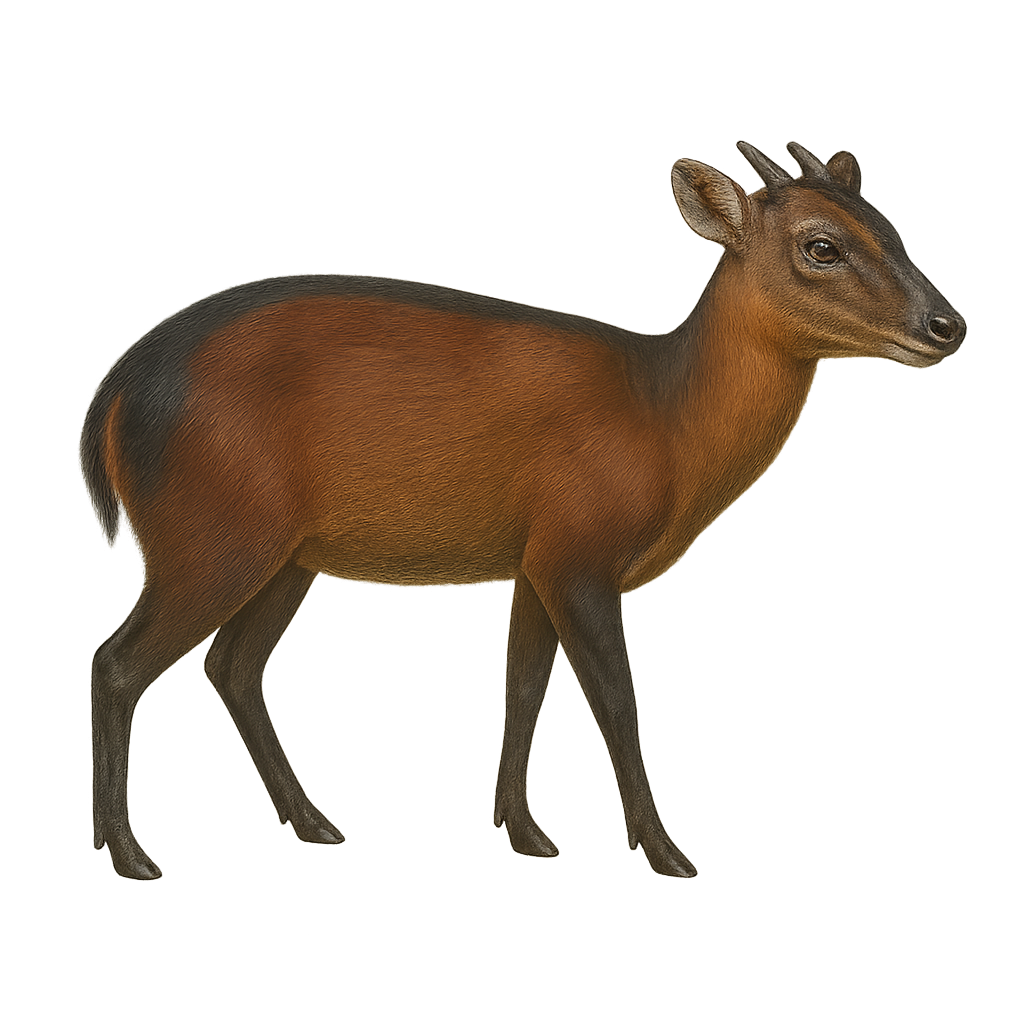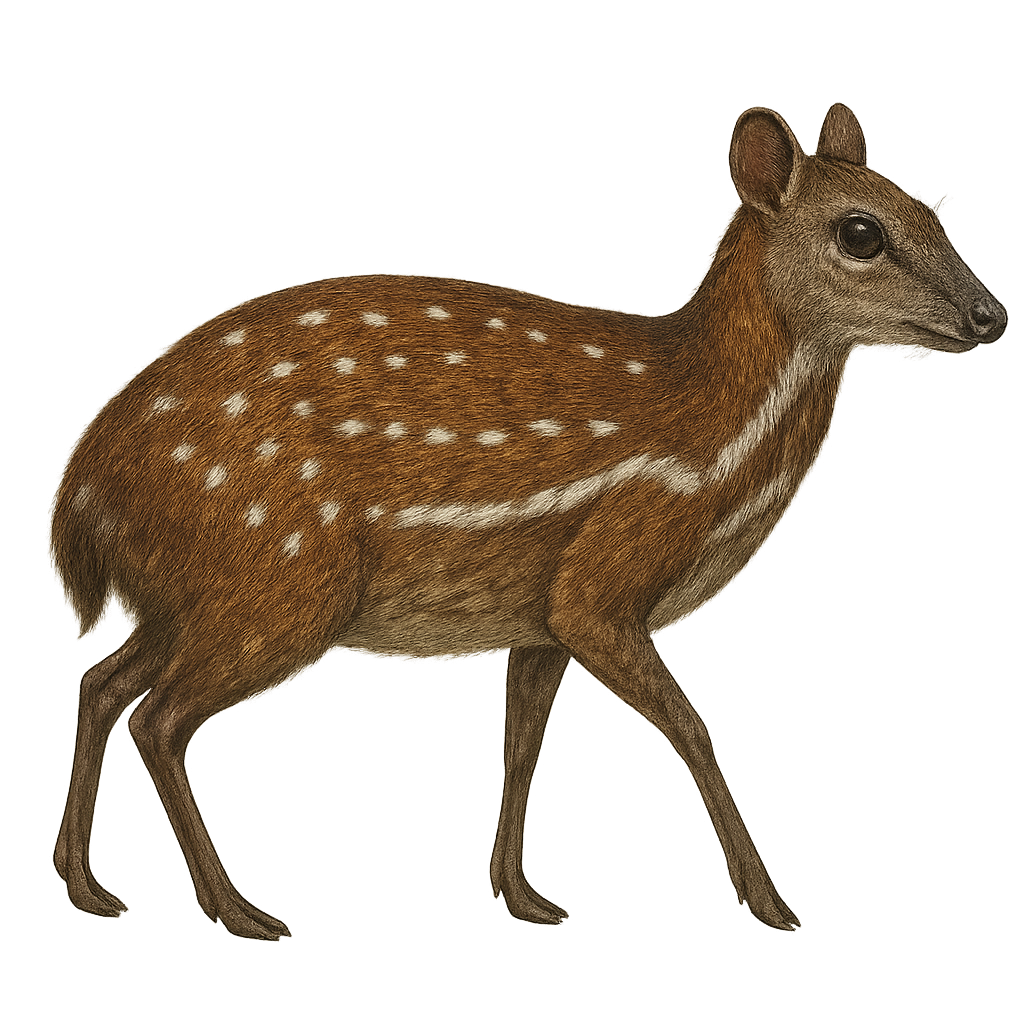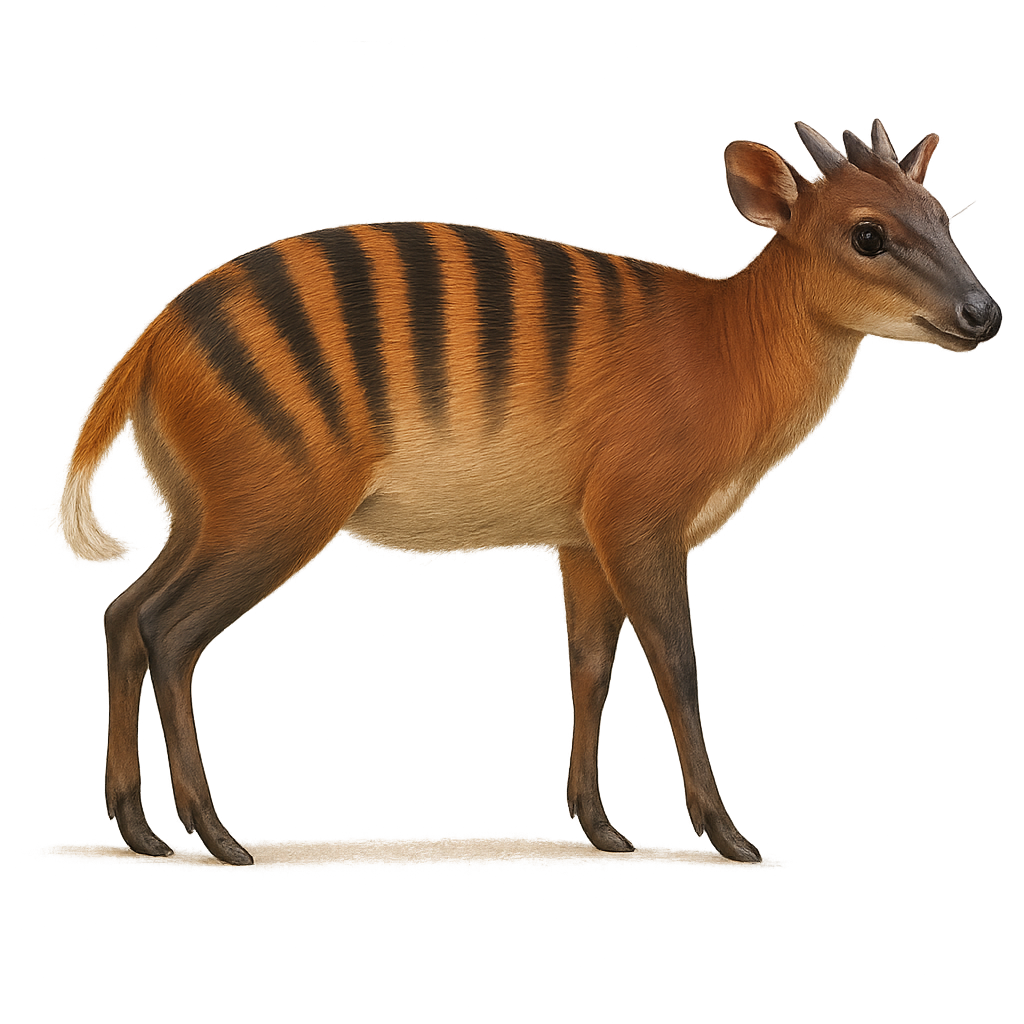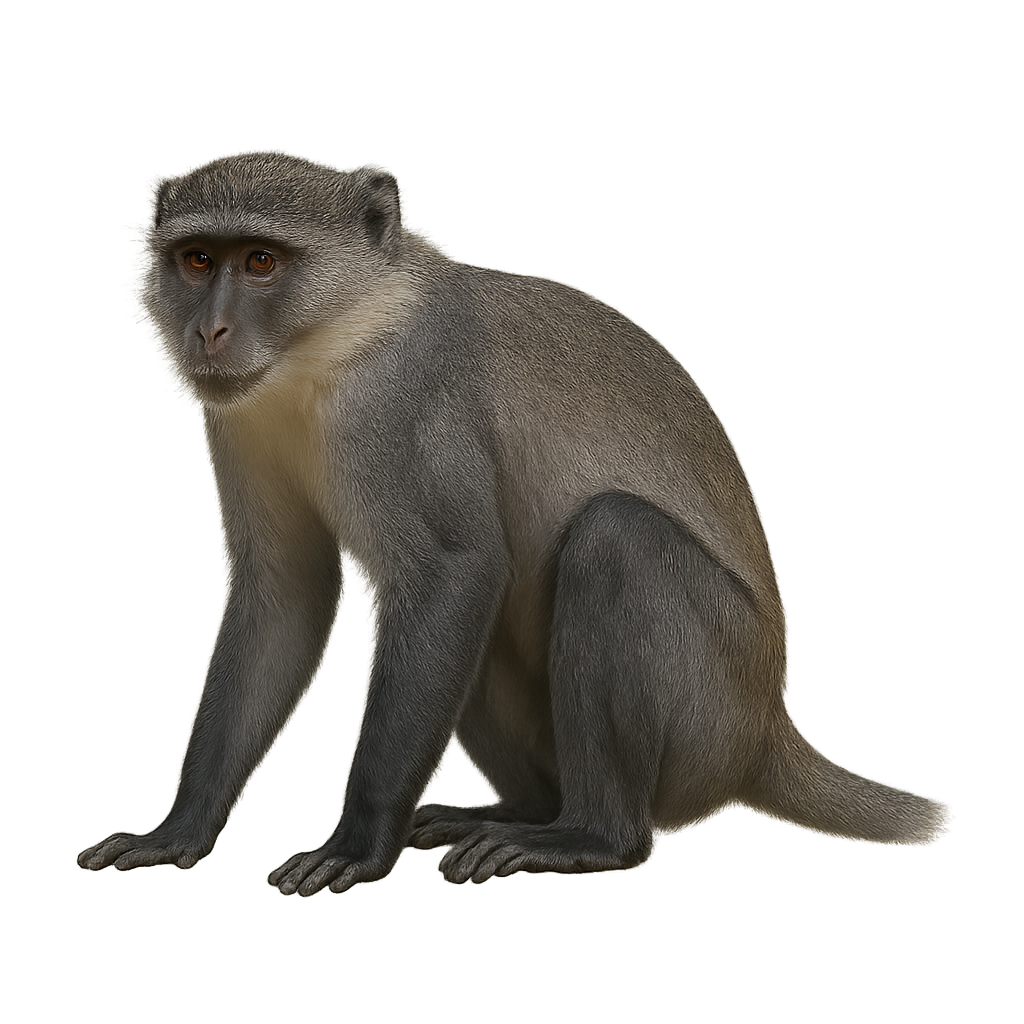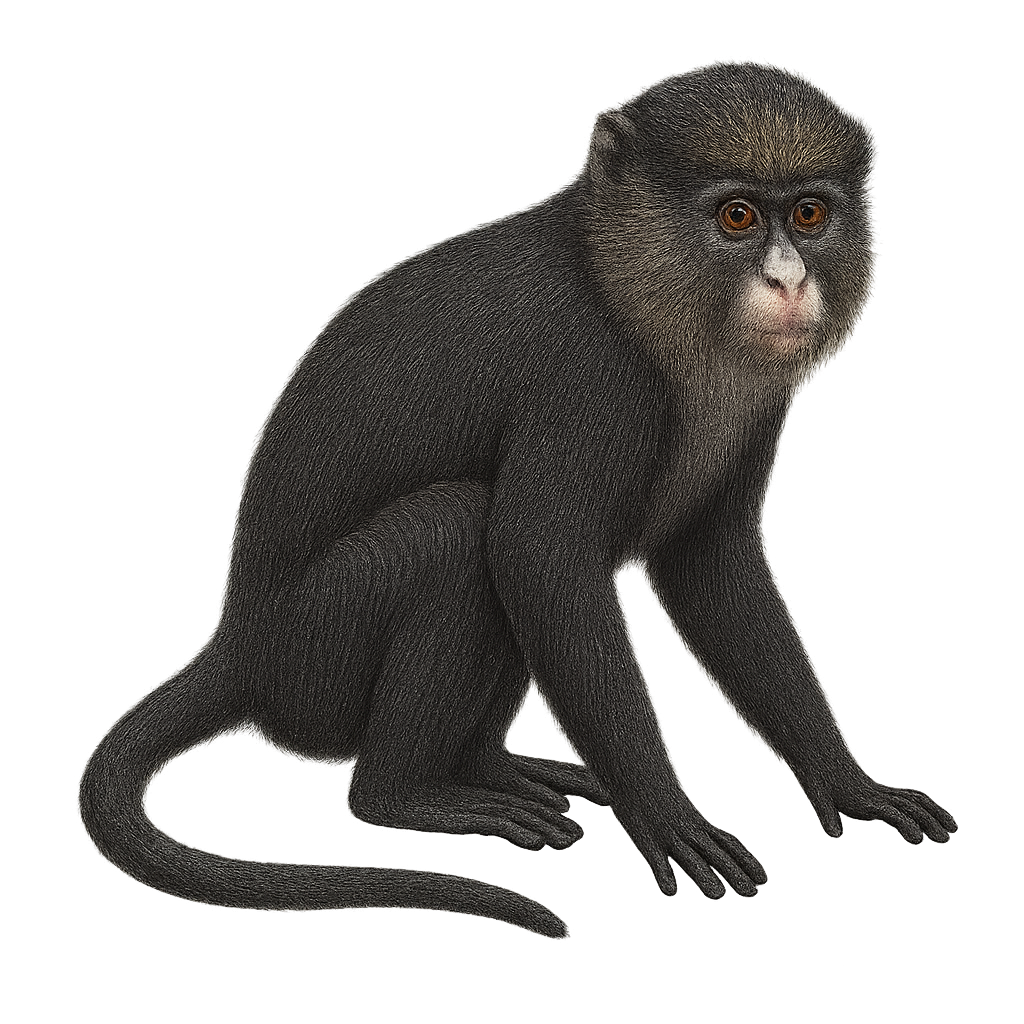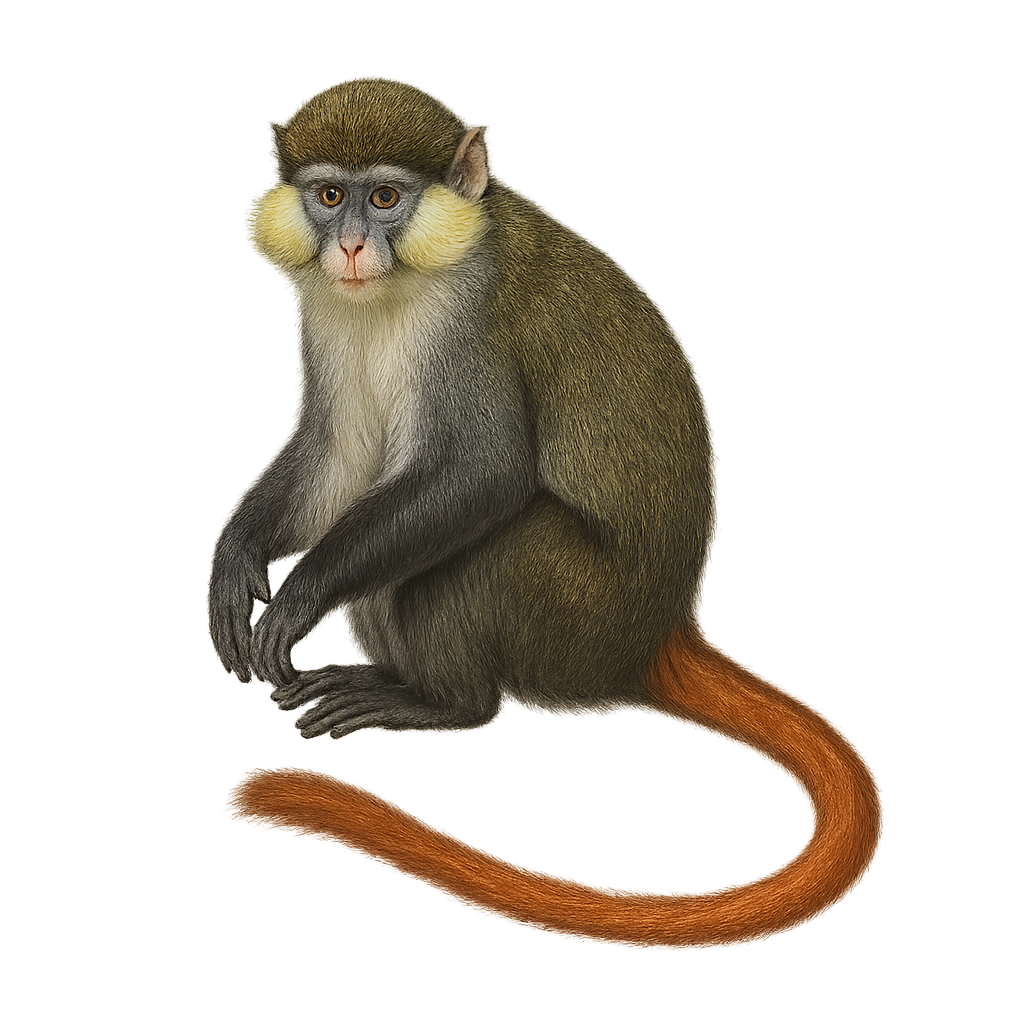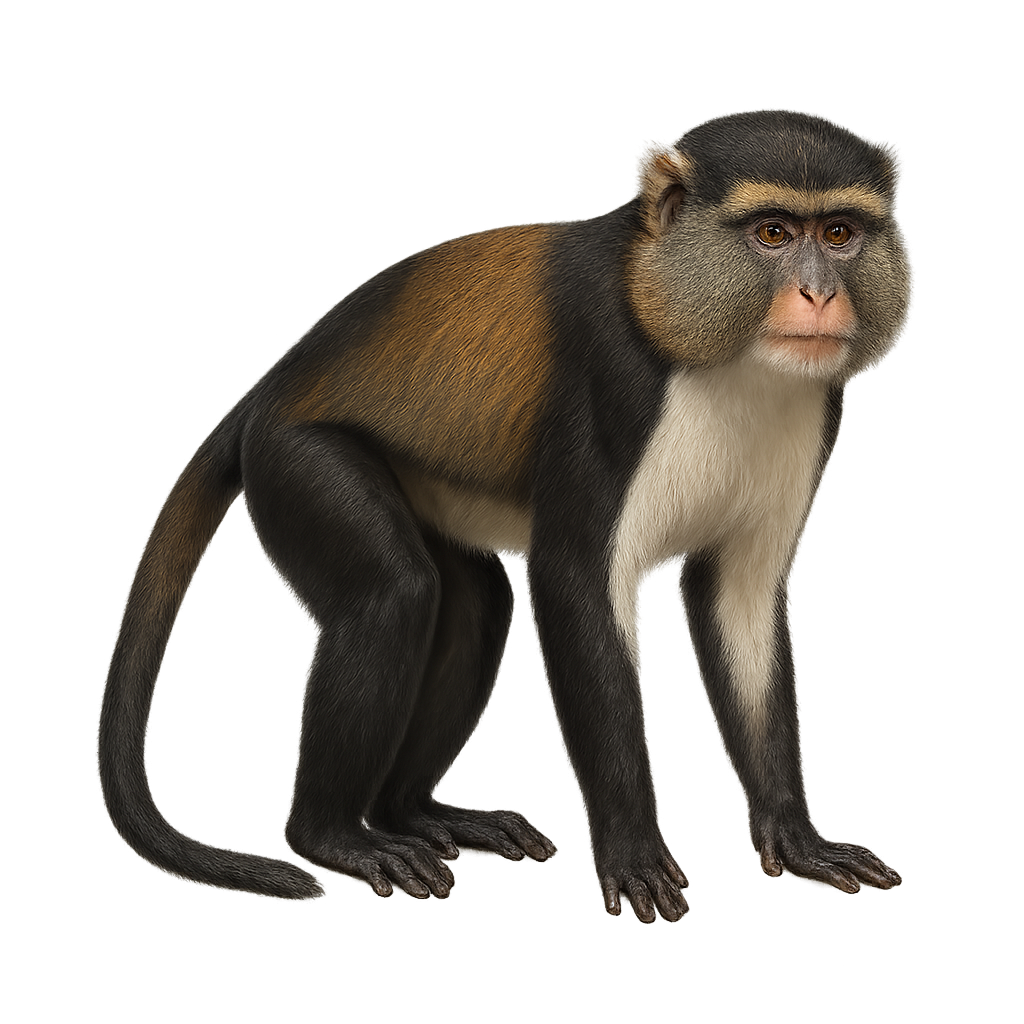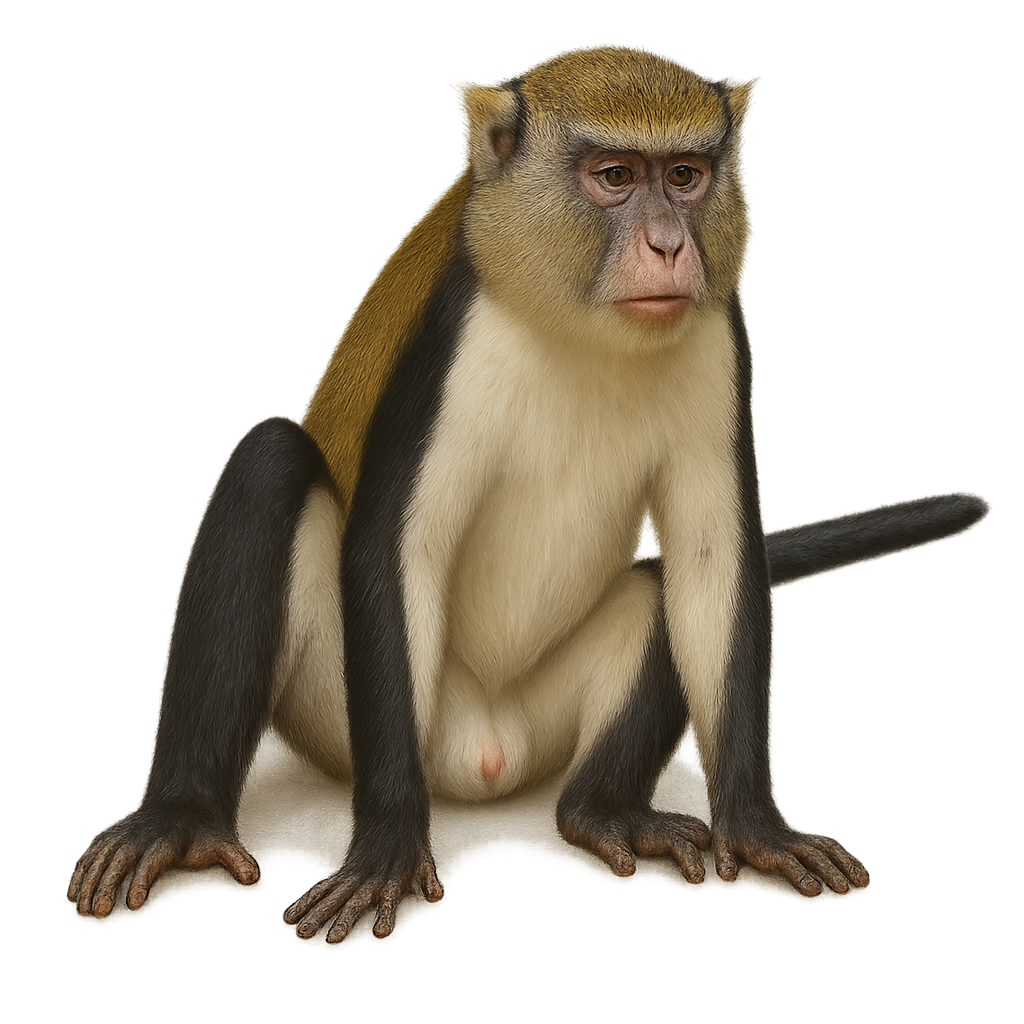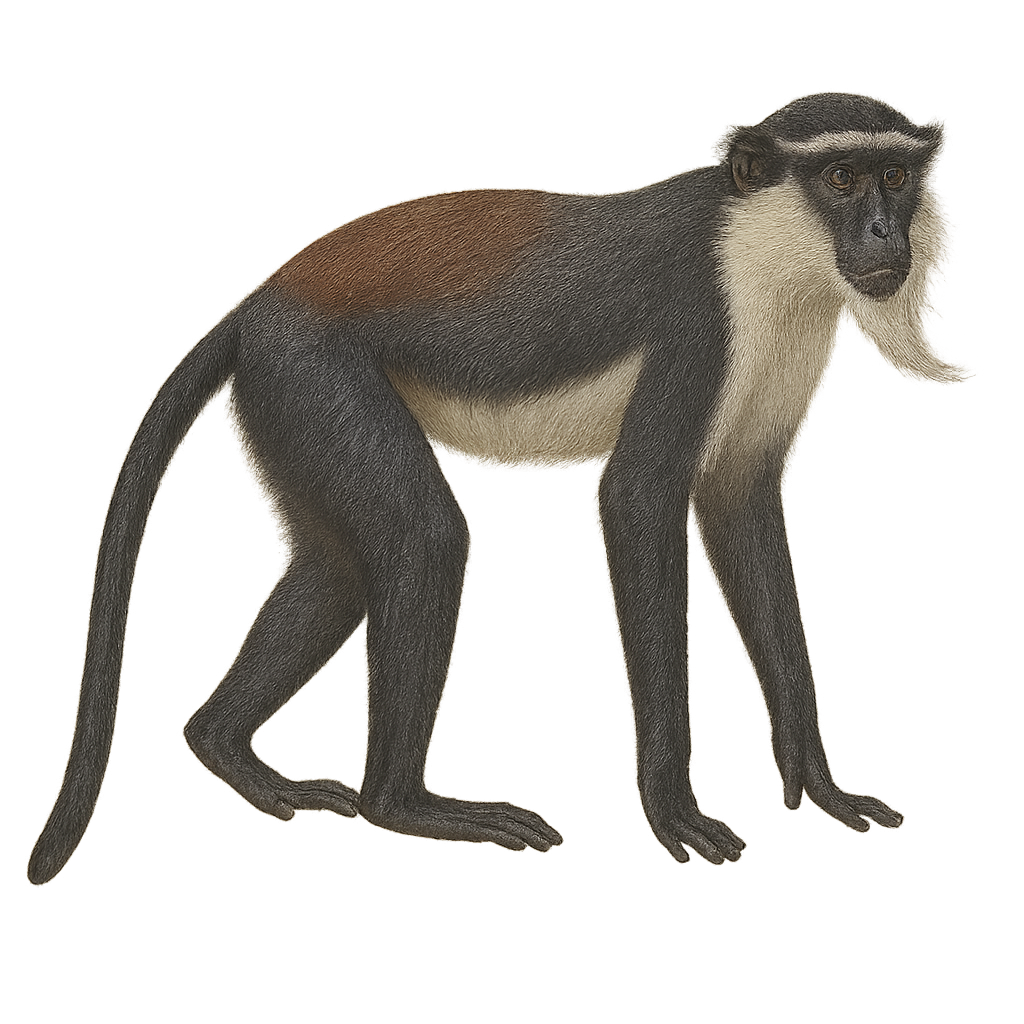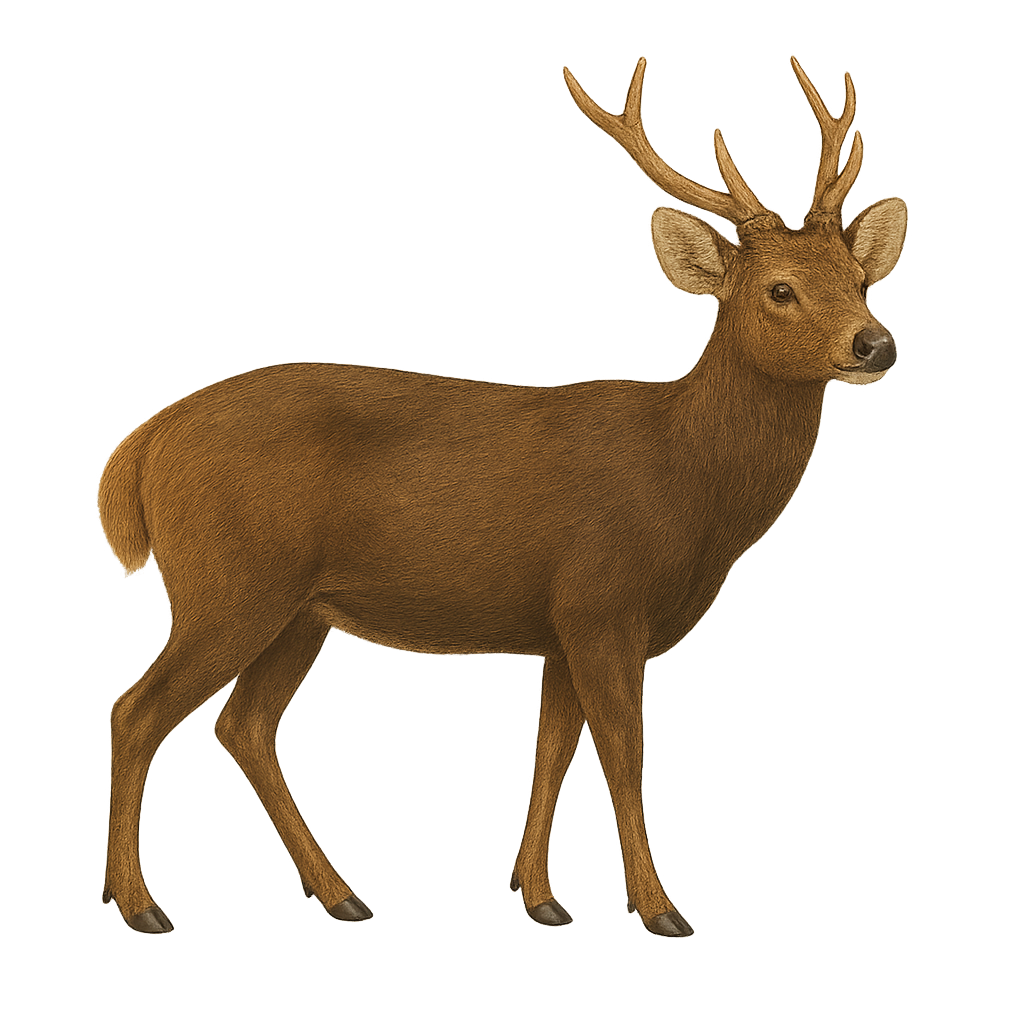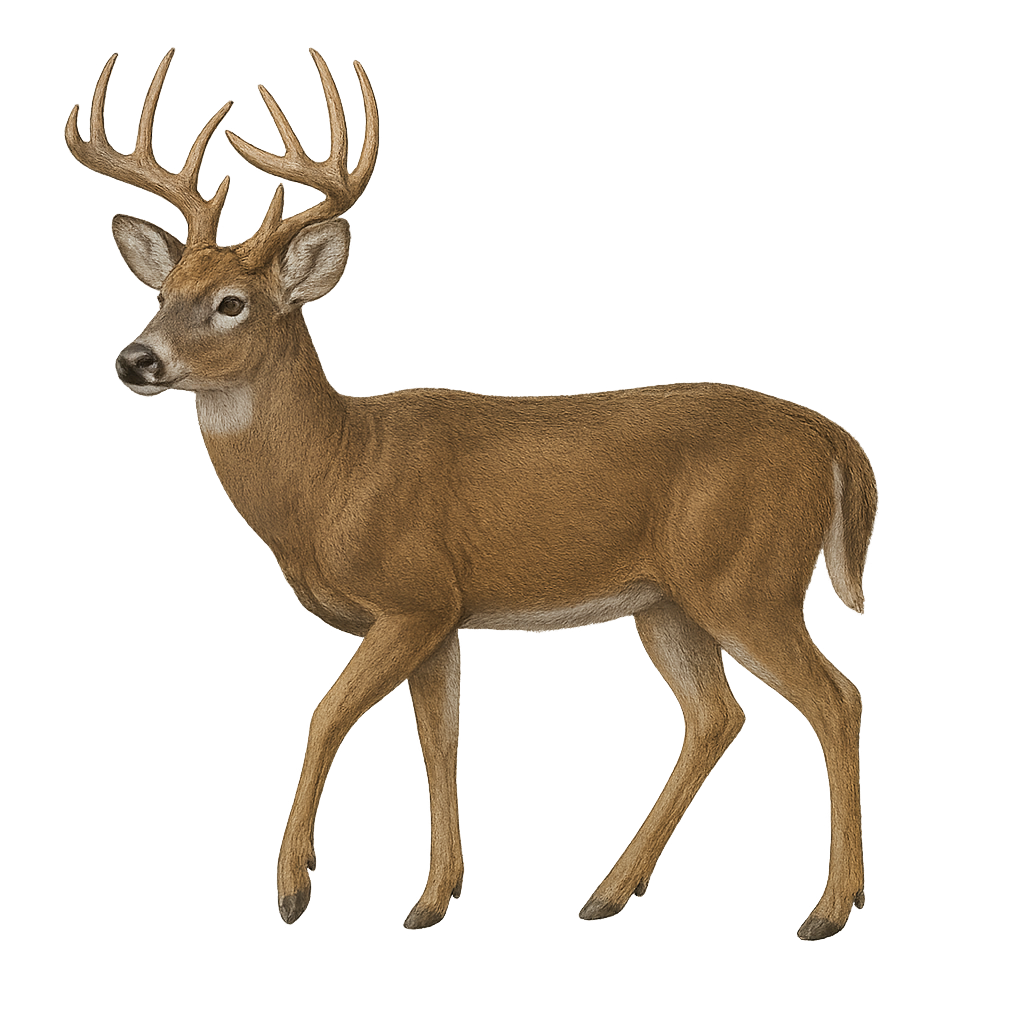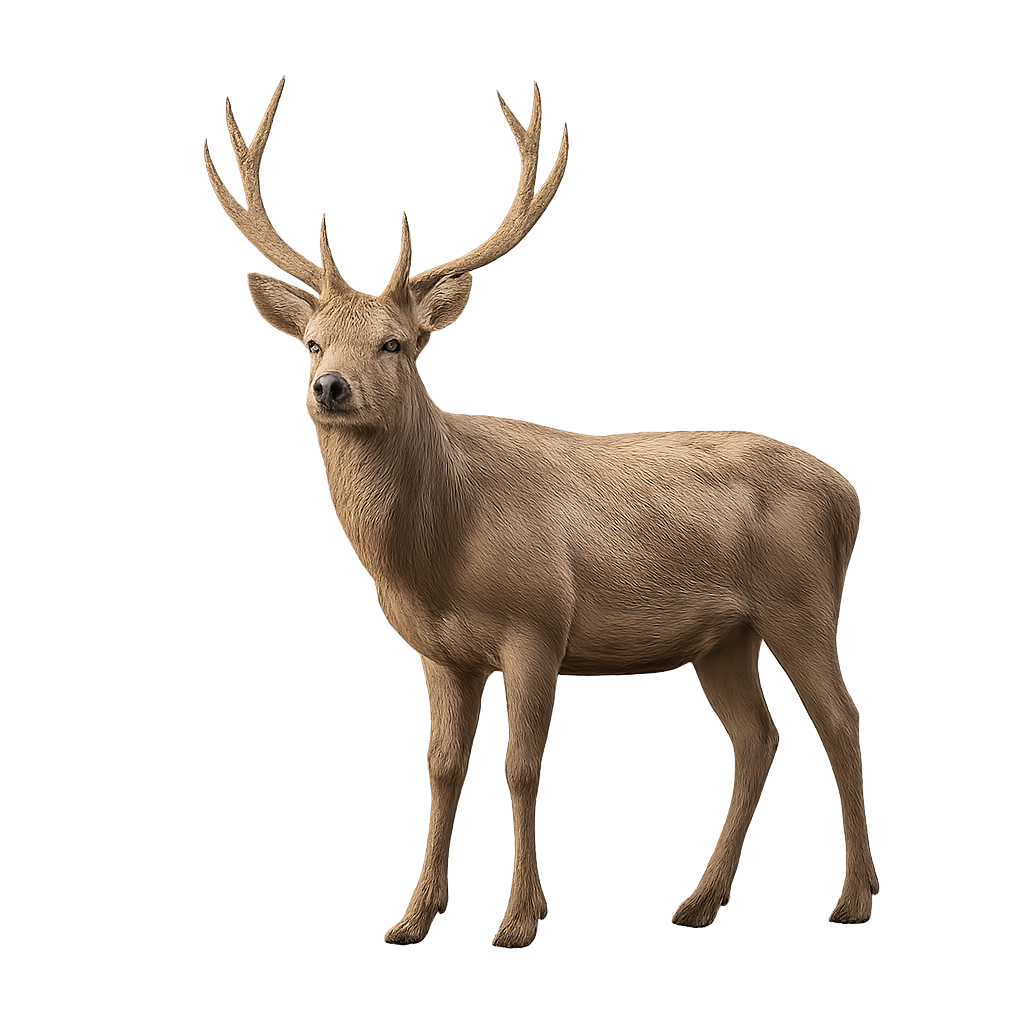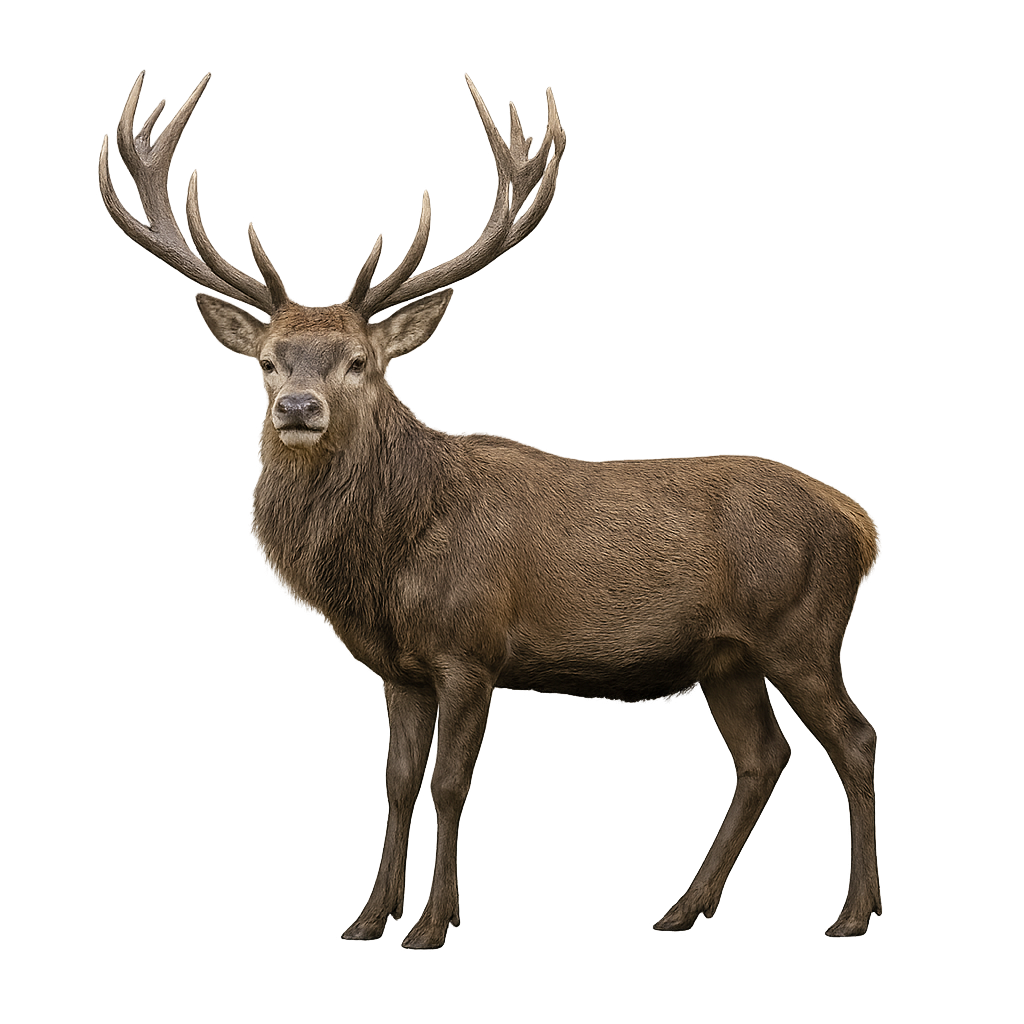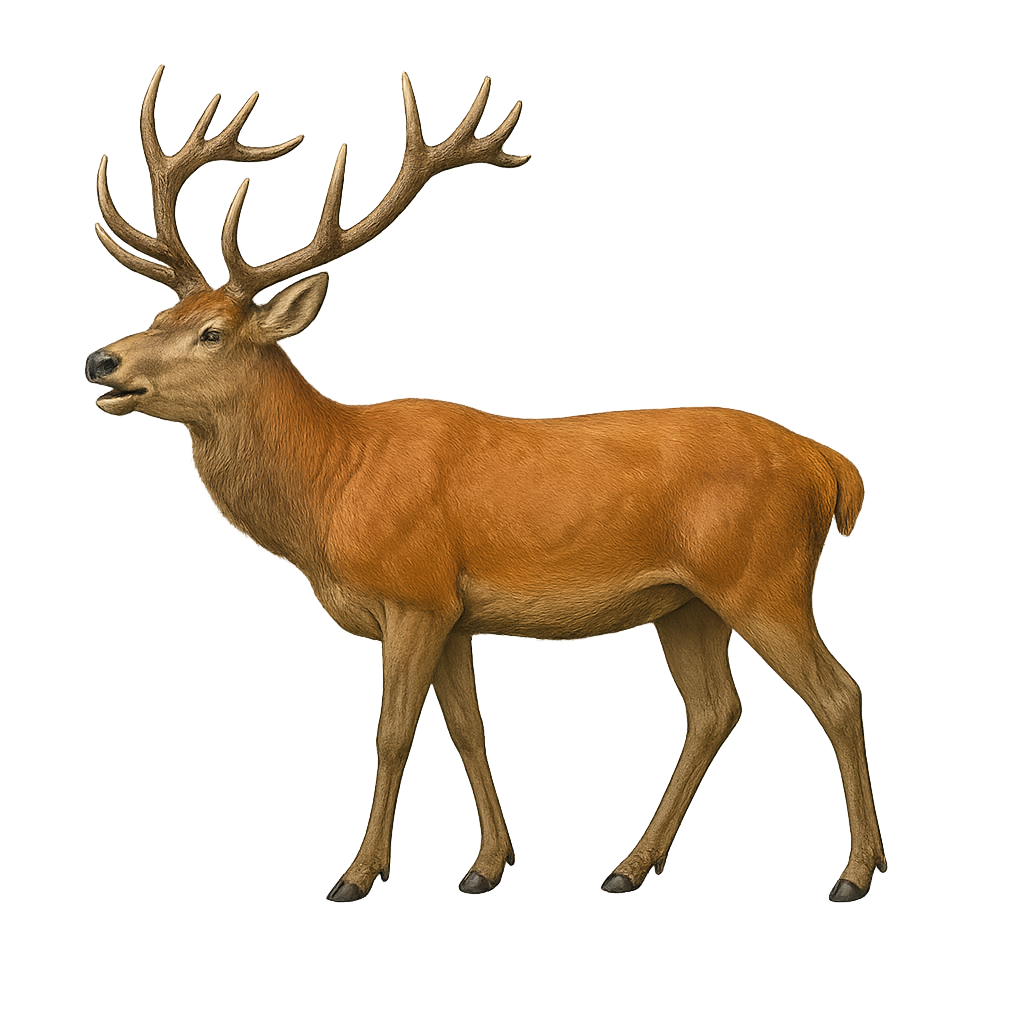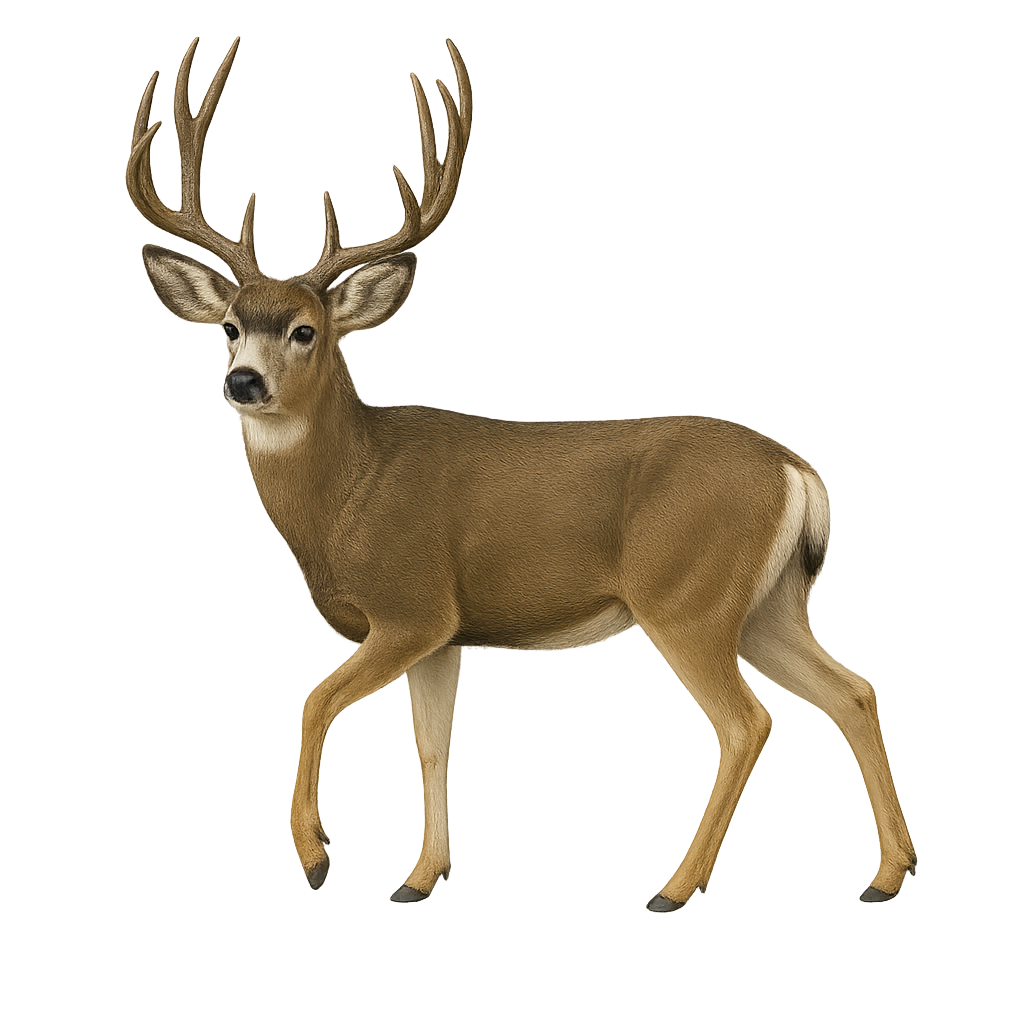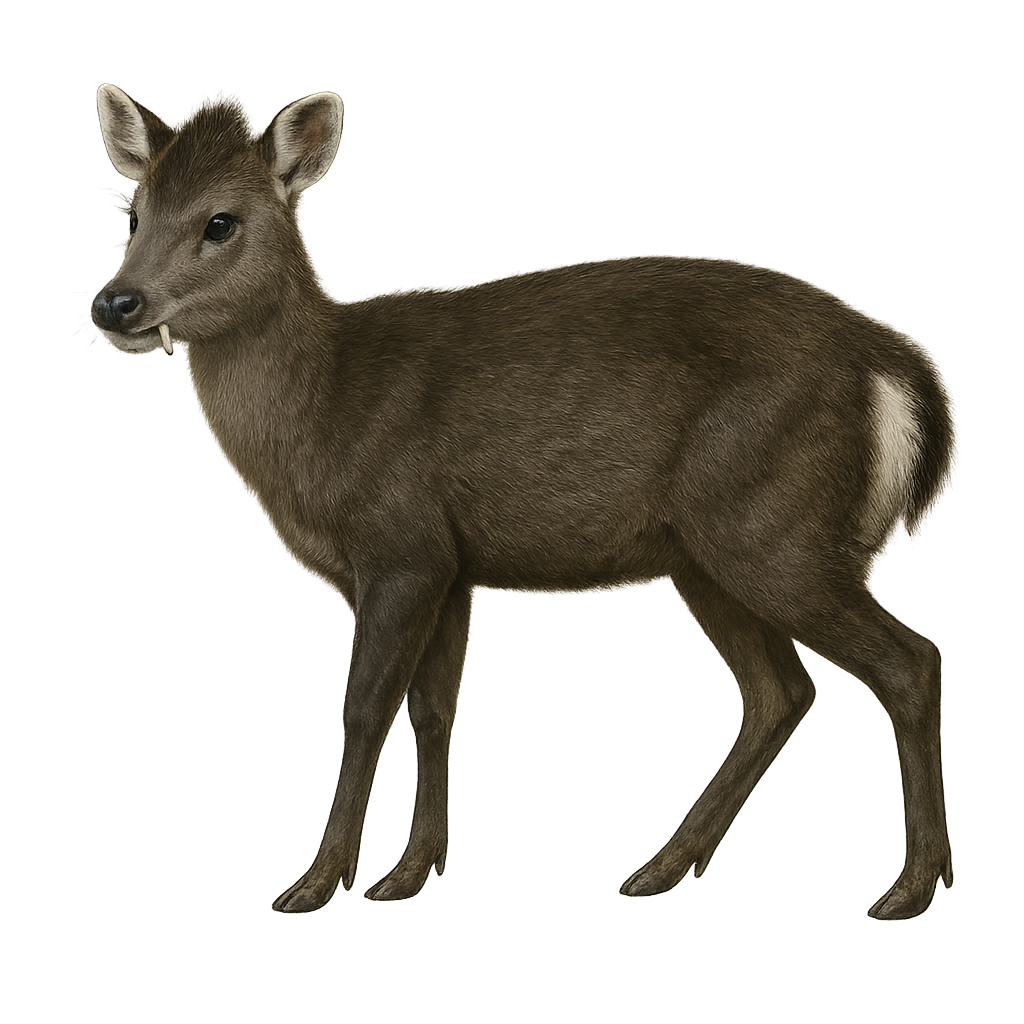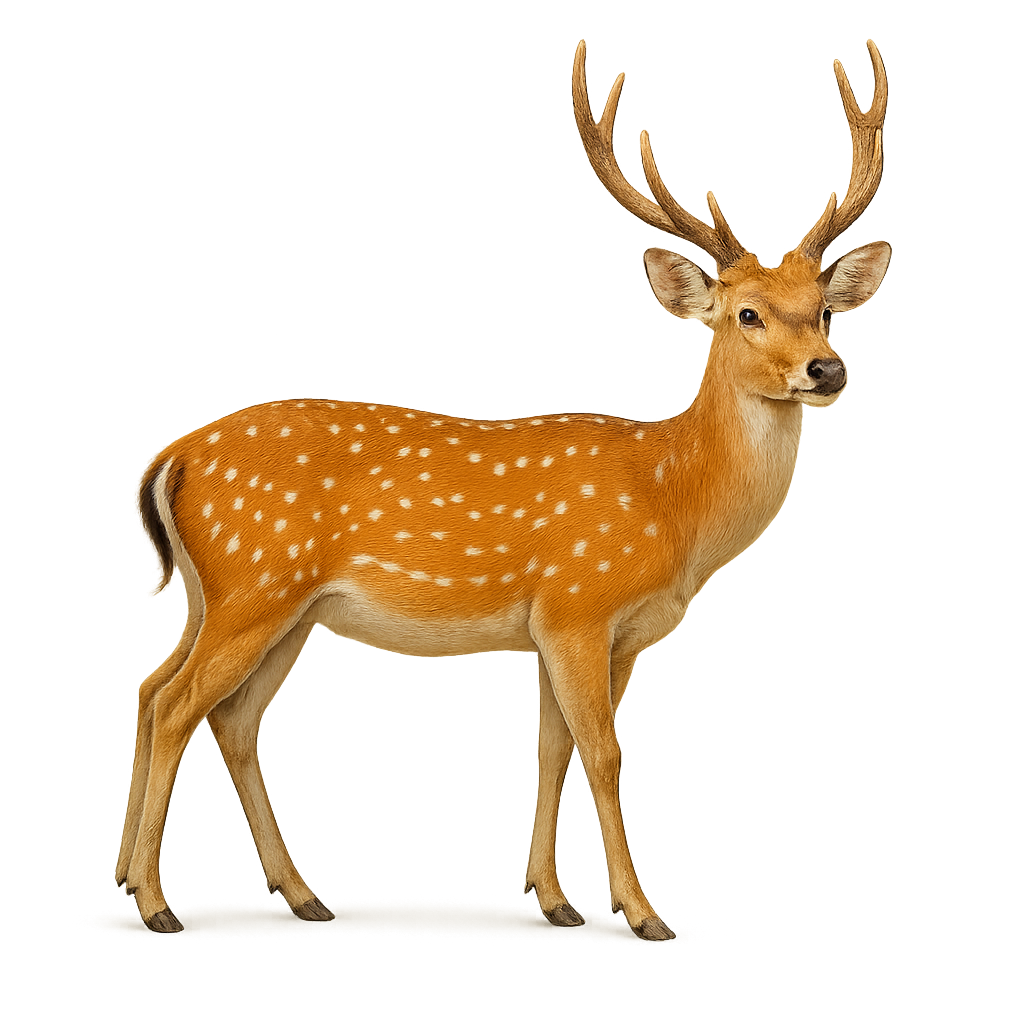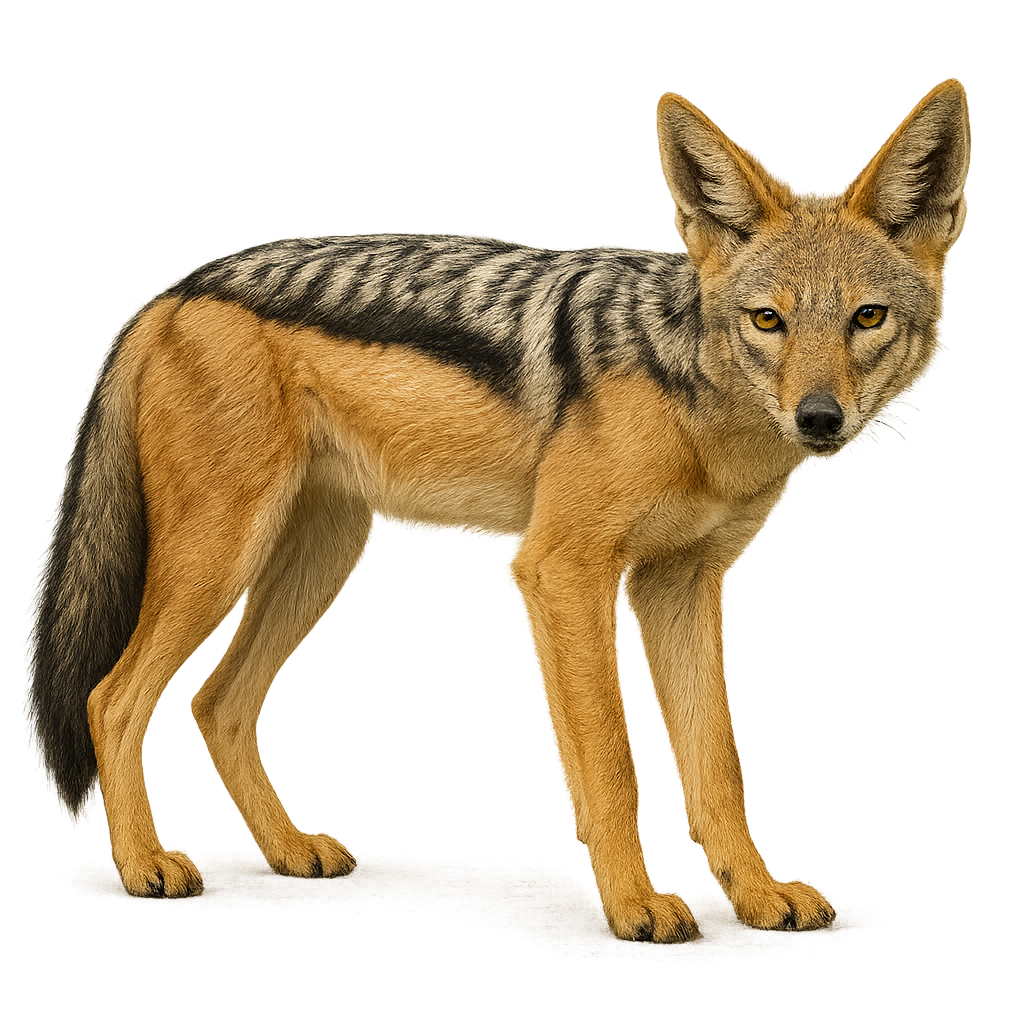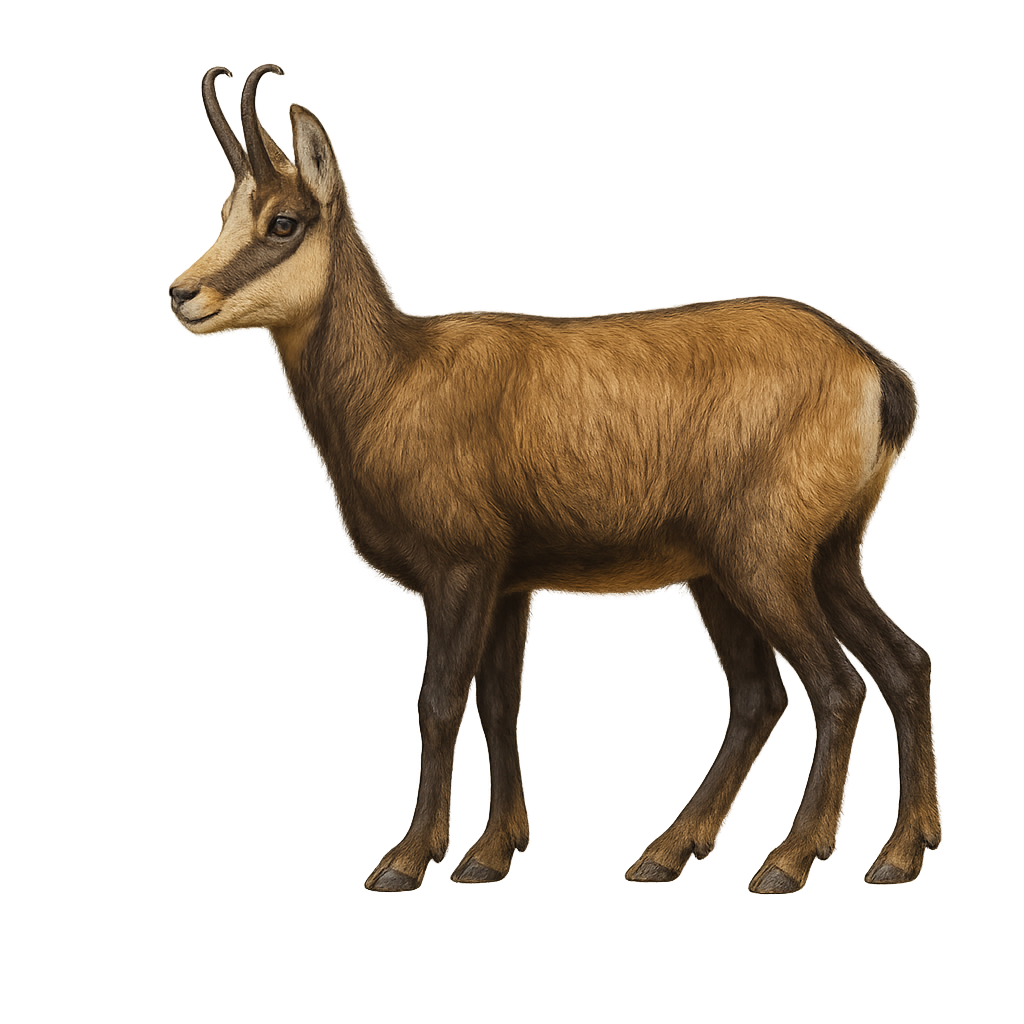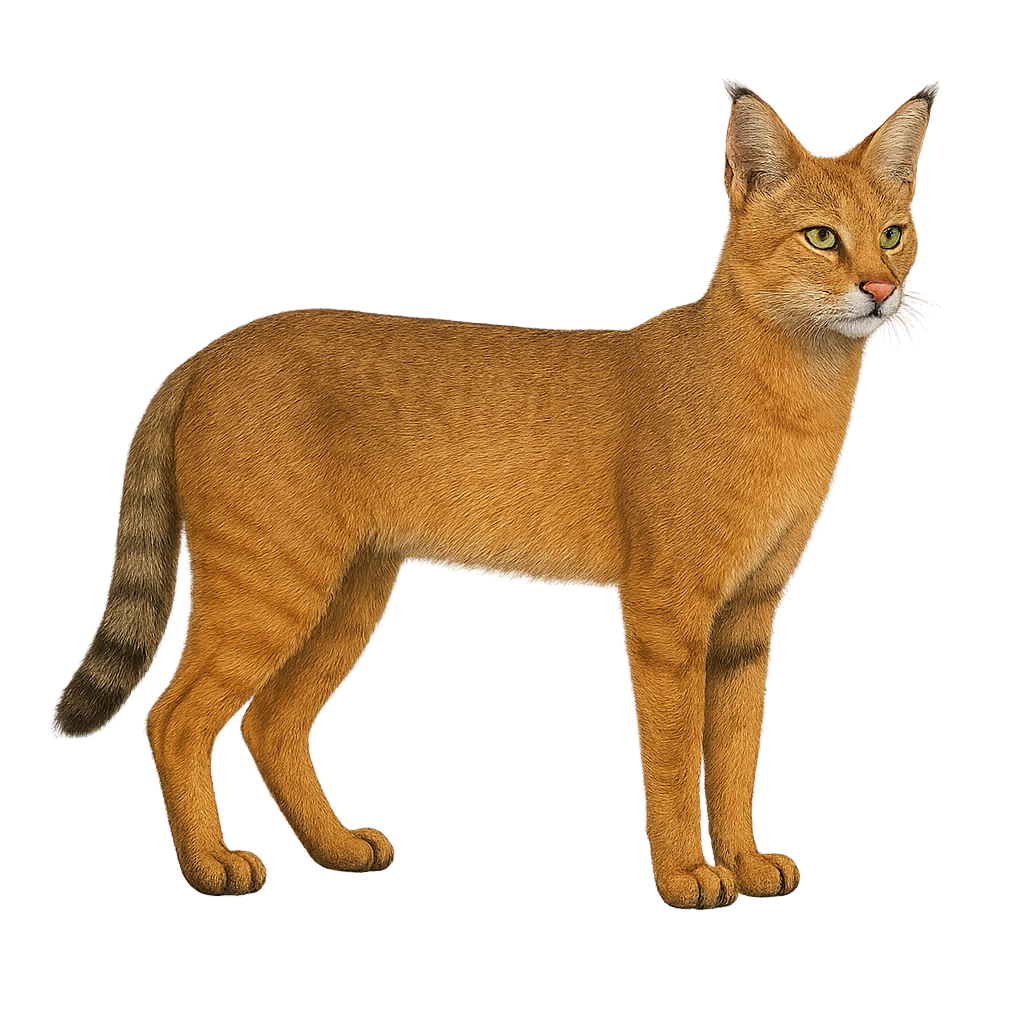The Bay Duiker, or Cephalophus dorsalis, is a small forest antelope native to West and Central Africa. It is characterized by its reddish-brown coat with a distinctive yellow dorsal stripe. Measuring about 70 cm in length and standing 45 cm at the shoulder, it weighs between 15 and 20 kg. Both sexes have short, slightly curved horns. This duiker is primarily solitary, though it may be seen in pairs during the breeding season. It feeds mainly on fruits, leaves, and young shoots, playing a crucial role in seed dispersal. Its natural habitat includes dense forests, where it uses its small size to navigate through thick vegetation.
The black-fronted duiker is a species of duiker, a small antelope found in the dense forests of West and Central Africa. It is easily recognizable by its distinctive black flanks and small size. This species is primarily herbivorous, feeding on fruits, leaves, and young shoots. While generally discreet and difficult to observe, it is threatened by deforestation and hunting. Its population is declining.
The water chevrotain, or Hyemoschus aquaticus, is a small, elusive mammal primarily inhabiting the tropical forests of West and Central Africa. This ruminant, belonging to the Tragulidae family, is often mistaken for a small deer due to its appearance. It has a brown coat with white spots, allowing it to blend seamlessly into its environment. Measuring about 80 cm in length and weighing between 7 and 16 kg, it is well-adapted to a semi-aquatic lifestyle, often seeking refuge in water to escape predators. Nocturnal and solitary, it feeds mainly on fruits, leaves, and young shoots.
The Weyns's Duiker is a small, elusive antelope native to the dense forests of Central Africa. It is characterized by its reddish-brown coat and short, straight horns. This mammal is typically solitary, although it can sometimes be seen in small family groups. It primarily feeds on leaves, fruits, and young shoots, playing a crucial role in seed dispersal. Its ability to move silently through dense vegetation makes it a challenging animal to spot in its natural habitat. Although not currently endangered, deforestation and hunting pose potential threats to its long-term survival.
The black duiker, or Cephalophus niger, is a small African antelope primarily found in the dense forests of West Africa. It is characterized by its dark, nearly black coat and compact size, measuring about 50 cm at the shoulder and weighing between 15 to 20 kg. Both sexes have short, slightly curved horns. Adapted to life in the undergrowth, it feeds mainly on fruits, leaves, and young shoots. Its discreet behavior and ability to slip through dense vegetation make it difficult to spot. It is often solitary, although pairs can sometimes be seen.
The Zebra du forest is a small antelope living in the dense forests of Central Africa. It is easily recognizable by its white and black stripes that cover its body, which help it camouflage in the underbrush. This discreet herbivore primarily feeds on leaves and fruits and remains mostly nocturnal or crepuscular. While it is a shy animal and difficult to spot, it is threatened by habitat loss and poaching.
The Diademed Monkey is a primate of the Cercopithecidae family, native to the tropical forests of Central Africa, primarily in the Democratic Republic of Congo, Uganda, and Kenya. This monkey is recognizable by the crest of hair on the top of its head, forming a 'diadem,' from which it gets its name. The Diademed Monkey is a social animal living in groups and feeds primarily on fruits, leaves, and insects. It is also known for its complex vocalizations and marked social behaviors, communicating with other group members to establish relationships and organize movements.
The Greater Spot-nosed Monkey, scientifically known as Cercopithecus nictitans, is a medium-sized arboreal primate found primarily in the tropical forests of West and Central Africa. It is distinguished by a characteristic white spot on its nose and a grey-green coat. This social monkey lives in hierarchical groups led by a dominant male. Omnivorous, it feeds on fruits, leaves, insects, and small animals. Its alarm call is used to warn the group of predators. Although its habitat is threatened by deforestation, it remains relatively widespread.
The Red-tailed monkey is an arboreal primate found mainly in the tropical forests of Central and East Africa. Recognizable by its distinctive red tail, it has a grey-green coat with white markings around the nose and eyes. This diurnal monkey lives in social groups of up to 30 individuals and primarily feeds on fruits, but also consumes leaves, flowers, and insects. Vocalizations are crucial for communication within the group, especially to alert others of predators. Although relatively common, deforestation and hunting pose threats to some local populations.
The Campbell's monkey is a medium-sized primate, recognizable by its olive-gray fur and black face surrounded by white hair. It primarily inhabits the tropical forests of West Africa, living in complex social groups. These monkeys are known for their sophisticated communication system, using a variety of calls to signal predators or other threats. They primarily feed on fruits, leaves, and insects. Although adaptable, deforestation and hunting pose threats to their survival. Their social behavior and intelligence make them a fascinating subject of study for primatologists.
The Lowe's Monkey is an arboreal primate found mainly in the tropical forests of West Africa. It is characterized by its grey-green fur and black face surrounded by white hair. This monkey is social and lives in groups of up to 30 individuals. It primarily feeds on fruits, leaves, and insects. Although its habitat is threatened by deforestation, it partially adapts to degraded areas. Its communication is rich, using varied vocalizations to alert its peers of dangers. The Lowe's Monkey plays a crucial role in seed dispersal, thus contributing to forest regeneration.
The Cercopithecus diana, or Diana monkey, is an arboreal primate native to the tropical forests of West Africa. It is distinguished by its black and white fur, with a characteristic crescent-shaped white band on its forehead. This monkey is agile and spends most of its time in trees, feeding mainly on fruits, leaves, and insects. Social groups usually consist of a dominant male and several females with their young. The Diana monkey is known for its varied vocalizations, used for communication within the group and to warn of predators. Unfortunately, it is threatened by deforestation and hunting, leading to a decline in its population.
The axis deer is a cervid native to the Indian subcontinent, recognized for its characteristic spotted coat. It primarily inhabits forests and open grasslands, where it feeds on leaves, fruits, and grasses. This social animal forms herds and is often seen grazing or resting in wooded areas. Although not threatened, it faces dangers from habitat loss and illegal hunting.
The hog deer, or Hyelaphus porcinus, is a medium-sized deer native to South and Southeast Asia. It is characterized by its stocky body and relatively short legs, giving it a robust appearance. Its coat is brown with lighter shades on the belly and underparts. Males have short, thick antlers, often used in dominance battles. This deer prefers grassland and wet forest habitats, where it primarily feeds on grasses, leaves, and fruits. Although generally solitary, the hog deer can form small groups, especially outside the rutting season. It is known for its ability to move quickly through dense vegetation, making it difficult to observe in its natural habitat.
The white-tailed deer, or Odocoileus virginianus, is a widespread cervid in North and South America. It is easily recognizable by its white tail, which it raises when alarmed. Males have antlers that they shed annually. The coat varies from reddish-brown in summer to gray-brown in winter, providing excellent camouflage. This deer is highly adaptable, living in various habitats from dense forests to open grasslands. It is primarily herbivorous, feeding on leaves, fruits, and young shoots. The white-tailed deer plays a crucial role in its ecosystem, influencing vegetation and serving as prey for many predators.
The Kashmir Stag, also known as the Hangul, is a majestic species primarily found in the mountains of the Himalayas and Kashmir. This deer is easily recognizable by its dense, woolly coat, which helps it withstand the cold temperatures of high altitudes. It has impressive antlers, which can grow to a considerable size in adult males. The females, on the other hand, are generally smaller and do not have antlers.
This deer inhabits high-altitude forests, alpine meadows, and mountainous regions covered in snow. It feeds primarily on herbaceous vegetation, foliage, and young shoots. The Kashmir Stag is a relatively shy and discreet animal, often living in small groups or family units. While its population remains relatively stable, it faces threats such as habitat loss due to deforestation and poaching, especially for its antlers.
The Maral Red Deer, a subspecies of the red deer, is a majestic cervid primarily inhabiting the mountainous and forested regions of Central Asia. Recognizable by its large size and impressive antlers, the maral symbolizes power and grace. Its coat ranges from brown to gray, lightening in winter. Males sport magnificent branched antlers, which they shed annually after the rutting season. The maral is a gregarious animal, living in herds, especially outside the breeding season. It primarily feeds on grasses, leaves, and young shoots. Although its habitat is threatened by human expansion, the maral remains an iconic species of Asian wildlife.
The mule deer is a North American deer species known for its large, mule-like ears. Its coat ranges from gray to brown, becoming lighter in winter. Males have branched antlers that they shed annually. Adapted to rugged terrain, they prefer mountainous and open forest habitats. Primarily herbivorous, they feed on leaves, grasses, and young shoots. Mule deer are social animals, often forming small groups, especially in winter. They are generally wary, making them challenging to approach.
The tufted deer, Elaphodus cephalophus, is a small deer species native to the mountainous forests of Asia, mainly in China and Myanmar. It is characterized by its modest size, standing about 50 to 70 cm at the shoulder, and its dark brown coat. Males have small antlers and prominent canines, giving them a distinctive appearance. This deer is primarily solitary, though it may occasionally be seen in small family groups. It is very discreet and prefers dense, wooded areas where it can hide from predators. The tufted deer is an herbivore, feeding on leaves, fruits, and young shoots.
The Sika Deer is a medium-sized cervid, native to East Asia, that is distinguished by its spotted coat, especially visible in young individuals and females. Its coat ranges from light brown to reddish, often sprinkled with small white spots that help it blend into its forested environment. The Sika Deer has antlers that, although smaller than those of the Red Deer, are well-developed in adult males. It primarily inhabits deciduous and coniferous forests, as well as mountainous areas.
The Sika Deer is an herbivore, feeding mainly on herbaceous plants, young shoots, and leaves. It is a social animal, living in groups, especially during the breeding season. Outside of this period, Sika Deer may be more solitary or live in small family units. While its population remains stable in certain regions, the Sika Deer is sometimes considered an invasive species in other parts of the world, particularly in Europe, where it has been introduced and can compete with local species.
The black-backed jackal, or Canis mesomelas, is a medium-sized canid easily recognized by its distinctive coat. It features a black back contrasting with the rest of its body, which is usually tawny or grayish. This opportunistic predator is primarily nocturnal, although it can be active at dusk. It inhabits various environments, from savannas to semi-desert areas. The black-backed jackal is a social animal, often seen in pairs or small family groups. Its communication relies on a variety of vocalizations, including howls and barks. Although wary of humans, it adapts well to human-modified environments.
The Black-backed Jackal, also known as the silver-backed jackal, is a small canid native to Africa, particularly found in savannas and open grasslands. It is distinguished by its grayish coat with a black stripe running along its back, hence the name "black-backed". This coat helps it blend effectively into its environment. The Black-backed Jackal has a slender body and relatively long legs, allowing it to run at high speeds.
An opportunistic carnivore, it primarily feeds on small mammals, birds, insects, and carrion, but it can also eat fruits and plants. Although it is a solitary animal, the Black-backed Jackal can occasionally be seen in small groups, especially during the breeding season. While its status is not particularly threatened, it faces competition from other predators and the loss of its natural habitat.
The Striped Jackal is a small canid found primarily in Africa, inhabiting savannas, open forests, and mountainous regions. It is distinguished by the dark stripes along its flanks, which give it a unique appearance among other jackals. Its coat is typically brown-gray, with lighter markings on the belly and underside of the legs, helping it blend into its natural environment.
The Striped Jackal is an opportunistic carnivore, feeding on small mammals, insects, fruits, and sometimes carrion. While it is primarily solitary, it can occasionally be seen in small groups while foraging for food. A skilled hunter, it uses strategies to capture its prey. Like many canids, it faces threats such as habitat loss and competition with other predators, but its population remains relatively stable.
The side-striped jackal, Canis adustus, is a medium-sized canid found primarily in sub-Saharan Africa. It is distinguished by its gray-brown coat with distinctive white stripes along its sides. This opportunistic carnivore feeds on small mammals, birds, fruits, and carrion. It is often seen alone or in pairs, although family groups may form. Adapted to various habitats, it inhabits savannas, open forests, and agricultural areas. Although generally discreet, it may approach inhabited areas in search of food.
The Golden Jackal is a small canid found primarily in South Asia, the Middle East, and Southeastern Europe. It is easily recognizable by its golden fur, which ranges from pale yellow to golden brown, allowing it to blend into the landscapes of grasslands, open forests, and savannas. The Golden Jackal has a more slender body and relatively long legs compared to other jackals, enabling it to be an excellent runner.
Opportunistic by nature, the Golden Jackal feeds on a wide variety of prey, ranging from small mammals and birds to fruits and carrion. Although often solitary or in small family groups, the Golden Jackal can occasionally be seen in larger groups while foraging for food. It is also known for its varied vocalizations and skilled hunting behavior. While its population remains relatively stable, it faces threats such as habitat loss and human conflict.
The Alpine Chamois is an elegant and agile ungulate, well adapted to the mountainous environments of the Alps, Pyrenees, and other mountain regions of Europe. It is distinguished by its reddish-brown coat in the summer, which becomes more gray and thicker in the winter, helping it endure the cold temperatures. The Alpine Chamois has small, curved horns, present in both males and females, but larger in adult males.
This ruminant primarily inhabits rocky slopes, mountain forests, and alpine meadows, where it feeds mainly on herbaceous vegetation, mosses, and lichens. The Alpine Chamois is an excellent climber, able to move with agility over steep and rocky terrain. It is usually solitary or lives in small family groups, but may also gather in larger herds during the winter. Although its population is stable in many areas, the Alpine Chamois remains vulnerable to hunting and human disturbances in its mountainous habitats.
The black-footed cat, Felis nigripes, is one of Africa's smallest felines, measuring about 36 to 52 cm in length with a tail of 13 to 20 cm. It weighs between 1 and 2.5 kg. Its coat is spotted with black on a tawny background, allowing it to blend effectively into the dry grasses of its natural habitat. This feline is primarily nocturnal and solitary, hunting small rodents and birds. It is known for its tenacity and aggressiveness, capable of taking on prey larger than itself. Although rarely seen, it plays a crucial role in the ecosystem by regulating small animal populations.
The Pallas's Cat, or Otocolobus manul, is a small wild cat primarily found in the steppes and mountains of Central Asia. It measures about 50 cm in length, with a tail of about 20 to 30 cm, and weighs between 2 and 5 kg. It has a thick, dense coat that is light gray to beige, with dark stripes on the back and lighter spots on the belly, allowing it to blend perfectly into its environment. The cat is also known for its large, rounded ears and piercing eyes. The Pallas's Cat is a solitary, primarily nocturnal hunter that feeds on small mammals, birds, and insects. While it is an excellent predator, it is often difficult to spot due to its elusive nature and lifestyle in harsh terrain. The species is threatened by habitat loss, hunting, and competition with humans for natural resources. Conservation efforts are underway to protect the Pallas's Cat and its habitats.
The Felis chaus, or jungle cat, is a medium-sized feline primarily found in South and Southeast Asia. It is characterized by its reddish-brown fur, sometimes spotted, and ears adorned with small black tufts. This solitary predator is an excellent swimmer and climber, adapting to various habitats such as marshes, forests, and grasslands. Its diet mainly consists of small mammals, birds, and reptiles. Although generally wary of humans, it may approach inhabited areas in search of food. Its population is stable, but it is threatened by habitat loss and hunting.


